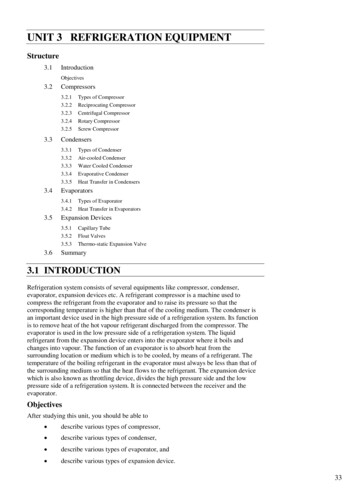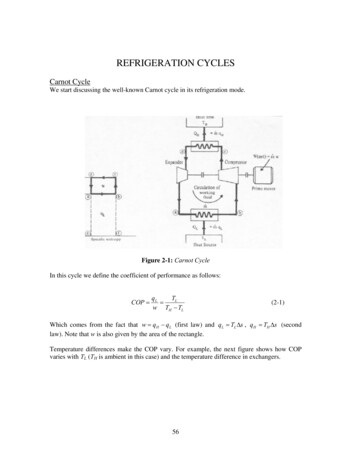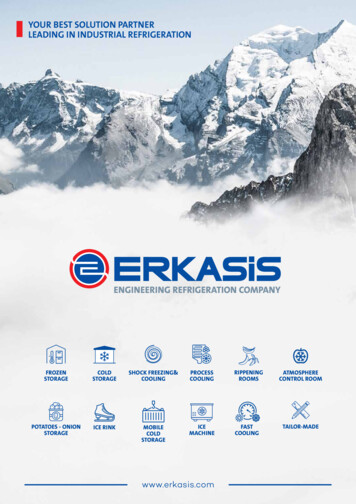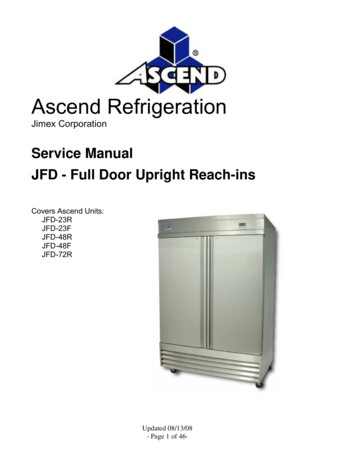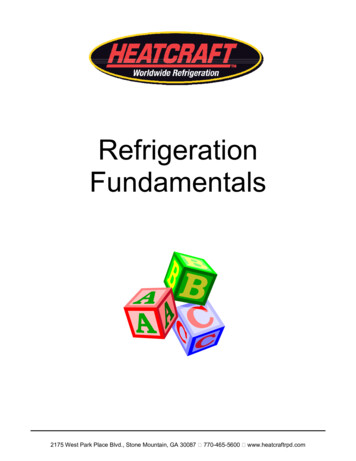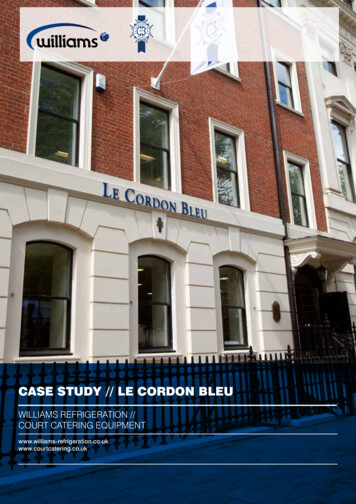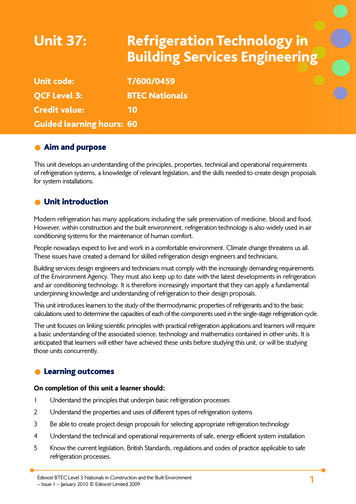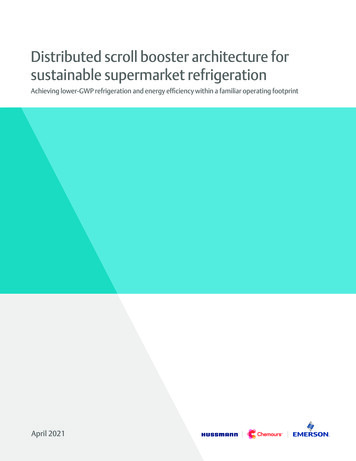
Transcription
Refrigeration ManualPart 4 - System Design
This is the fourth of a series of publications comprising the Emerson Climate Technologies,Inc. Refrigeration Manual. Although each separate part covers a specific area of refrigeration theory and practice, each successive publication presumes a basic understanding ofthe material presented in the previous sections.Part 1Part 2Part 3Part 4Fundamentals of RefrigerationRefrigeration System ComponentsThe Refrigeration LoadSystem DesignThe application and design recommendations are intended only as a general guide. Theexact requirements of a given installation can only be determined after the specific designcriteria and desired operating conditions are known. 1969 Emerson Climate Technologies, Inc.All rights reserved.
Part 4SYSTEM DESIGN Section 17. BASIC APPLICATIONRECOMMENDATIONSSection 19. LOW TEMPERATURE SYSTEMSSingle Stage Low Temperature Systems. 19-1Two Stage Low Temperature Systems. 19-2Volumetric Efficiency. 19-2Two Stage Compression andCompressor Efficiency. 19-2Compressor Overheating at ExcessiveCompression Ratios. 19-5Basic Two Stage System. 19-6Two Stage System Components. 19-6Piping on Two Stage Systems. 19-9Cascade Refrigeration Systems. 19-13Fundamental Design Principles. 17-1Compressor Selection. 17-1System Balance. 17-1Refrigerant. 17-2Compressor Cooling. 17-2Compressor Lubrication. 17-3Oil Pressure Safety Control. 17-3Oil Separators. 17 4Suction Line Accumulators. 17-4Pumpdown System Control. 17-5Crankcase Heaters. 17-5Crankcase Pressure Regulating Valves. 17-6Low Ambient Head Pressure Control. 17-6Liquid Line Filter-Drier. 17 6Sight Glass and Moisture Indicator. 17-7Liquid Line Solenoid Valve. 17-7Heat Exchanger. 17-7Thermostatic Expansion Valves. 17-7Evaporators. 17-8Suction Line Filters. 17-9High and Low Pressure Controls. 17-9Interconnected Systems. 17-10Electrical Group Fusing. 17-10Section 20. TRANSPORT REFRIGERATIONCompressor Cooling. 20-1Compressor Speed. 20-1Compressor Operating Position. 20-2Compressor Drive. 20-2Refrigerant Charge. 20-2Refrigerant Migration. 20-2Oil Charge. 20-3Oil Pressure Safety Control. 20-3Oil Separators. 20-3Crankcase Pressure Regulating Valve. 20-3Condenser. 20-4Receiver. 20-4Purging Air in a System. 20-4Liquid Line Filter-Drier. 20-4Heat Exchanger. 20-5Liquid Line Solenoid Valve. 20-5Suction Line Accumulator. 20-5Crankcase Heaters. 20-5Pumpdown Cycle. 20-5Forced Air Evaporator Coils. 20-5Thermostatic Expansion Valves. 20-6Defrost Systems. 20-6Thermostat. 20-7High-Low Pressure Control. 20-7Eutectic Plate Applications. 20-7Refrigerant Piping. 20-10Vibration. 20-10Electrical Precautions. 20-10Installation. 20-11Field Troubleshooting on Transport Units. 20-12Section 18. REFRIGERATION PIPINGBasic Principles of RefrigerationPiping Design. 18-1Copper Tubing for Refrigerant Piping. 18-2Fittings for Copper Tubing. 18-2Equivalent Length of Pipe. 18-2Pressure Drop Tables. 18-5Sizing Hot Gas Discharge Lines. 18-5Sizing Liquid Lines. 18-14Sizing Suction Lines. 18-15Double Risers. 18-21Suction Piping for Multiplex Systems. 18-22Piping Design for Horizontal andVertical Lines. 18-23Suction Line Piping Design at theEvaporator. 18-24Receiver Location. 18-25Vibration and Noise. 18-25Recommended Line Sizing Tables. 18-261 1969 Emerson Climate Technologies, Inc.All rights reserved.
Section 21. CAPACITY CONTROLInternal Capacity Control Valves.21-1External Capacity Control Valves.21-1Hot Gas Bypass.21-1Bypass into Evaporator Inlet.21-3Bypass into Suction Line.21-3Solenoid Valves for Positive Shut-offand Pumpdown Cycle.21-5Desuperheating Expansion Valve.21-5Typical Multiple-EvaporatorControl System.21-5Power Consumption withHot Gas Bypass.21-6Section 22. LIQUID REFRIGERANT CONTROLIN REFRIGERATION AND AIR CONDITIONINGSYSTEMSRefrigerant-Oil Relationship.22-1Refrigerant Migration.22-1 1969 Emerson Climate Technologies, Inc.All rights reserved.Liquid Refrigerant Flooding.22-2Liquid Refrigerant Slugging.22-2Tripping of Oil Pressure Safety Control.22-2Recommended Corrective Action.22-2Section 23. ELECTRICAL CONTROL CIRCUITSTypical Lockout Control Circuit.23-1Control Circuit for CompressorProtection Against LiquidRefrigerant Flooding.23-3Control Circuits to Prevent Short Cycling.22-3Control Circuits for Compressors withCapacity Control Valves.23- 5
INDEX OF TABLESTable 20AVentilation Air Requirements for Machine Rooms CFM/1000 BTU/HR at10 F. Air Temperature Rise. 17-3Table 21Recommended Minimum Low Pressure Control Setting. 17-9Table 22Dimensions and Properties of Copper Tube. 18-3Table 23Weight of Refrigerant in Copper Lines. 18-4Table 24Equivalent Length in Feet of Straight Pipe For Valves and Fittings. 18-5Table 25Pressure Drop Equivalent for 2 F. Change in Saturation Temperature atVarious Evaporating Temperatures. 18-15Table 26Maximum Recommended Spacing Between Pipe Supports for Copper Tubing. 18-26Table 27Recommended Liquid Line Sizes. 18-27Table 28Recommended Discharge Lines Sizes. 18-28Table 29Recommended Suction Line Sizes, R-12, 40 F. 18-29Table 30Recommended Suction Line Sizes, R-12, 25 F. 18-30Table 31Recommended Suction Line Sizes, R-12, 15 F. 18-31Table 32Recommended Suction Line Sizes, R-12, –20 F. 18-31Table 33Recommended Suction Line Sizes, R-12, –40 F. 18-32Table 34Recommended Suction Line Sizes, R-22, 40 F. 18-32Table 35Recommended Suction Line Sizes, R-22, 25 F. 18-33Table 36Recommended Suction Line Sizes, R-22, 15 F. 18-34Table 37Recommended Suction Line Sizes, R-22, –20 F. 18-35Table 38Recommended Suction Line Sizes, R-502, 25 F. 18-35Table 39Recommended Suction Line Sizes, R-502, 15 F. 18-36Table 40Recommended Suction Line Sizes, R-502, –20 F. 18-37Table 41Recommended Suction Line Sizes, R-502, –40 F. 18-38Table 42Efficiency Comparison of Single Stage vs. Two Stage Compression TypicalAir Cooled Application with Refrigerant R-502. 19-6Table 43Recommended Discharge Line Sizes for Two Stage Compressors. 19-10Table 44Recommended Liquid Line Sizes for Two Stage Compressors. 19-10Table 45Recommended Suction Line Sizes for Two Stage Compressors, –60 F. 19-11Table 46Recommended Suction Line Sizes for Two Stage Compressors, –60 F. 19-11Table 47Recommended Suction Line Sizes for Two Stage Compressors, –80 F. 19-12Table 48Recommended Suction Line Sizes for Two Stage Compressors, –80 F. 19-12 1969 Emerson Climate Technologies, Inc.All rights reserved.
Section 17BASIC APPLICATION RECOMMENDATIONSFUNDAMENTAL DESIGN PRINCIPLESOperation at evaporating temperatures above the approved operating range may overload the compressormotor. Operation at evaporating temperatures below theapproved operating range is normally not a problem ifthe compressor motor can be adequately cooled, anddischarge temperatures can be kept within allowable limits. Evaporating temperatures below -40 F. are normallybeyond the practical lower limit of single stage operationbecause of compressor inefficiencies and excessivedischarge gas temperatures. Because of problems ofmotor cooling or overloading, some motor-compressorsmay have approval for operation at limited condensingor evaporating temperatures within a given range, andif so, these limitations will be shown by limited performance curves on the specification sheet.There are certain fundamental refrigeration designprinciples which are vital to the proper functioning ofany system.1. The system must be clean, dry, and free from allcontaminants.2. The compressor must be operated within safetemperature, pressure, and electrical limits.3. The system must be designed and operated so thatproper lubrication is maintained in the compressorat all times.4. The system must be designed and operated so thatexcessive liquid refrigerant does not enter the compressor. Refrigeration compressors are designedto pump refrigerant vapor, and will tolerate only alimited quantity of liquid refrigerant.A given compressor may be approved in two differentoperating ranges with different refrigerants, for example,high temperature R-12 and low temperature R-502. Sincethe power requirements for a given displacement withboth R-22 and R-502 are somewhat similar, in somecases a compressor may be approved in the sameoperating range for either of these refrigerants.5. Proper refrigerant feed to the evaporator must bemaintained, and excessive pressure drop in therefrigerant piping must be avoided.Two stage compressors may be approved for evaporating temperatures as low as -80 F., but individualcompressor specifications should be consulted for theapproved operating range.If these give steps are accomplished, then operation ofthe system is reasonably certain to be trouble free. Ifany one is neglected, then eventual operating problemsare almost certain to occur. These basic fundamentalsare closely inter-related, and must always be kept inmind with regard to the application of any component,or whenever any change in system operation is contemplated.Operation at temperatures below -80 F. is normallybeyond the practical efficiency range of Copeland brand two stage compressors, and for lower evaporatingtemperatures, cascade systems should be employed.COMPRESSOR SELECTIONCompressors with unloaders have individually established minimum operating evaporating temperaturessince motor cooling is more critical with these compressors. As the compressor is unloaded, less refrigerant iscirculated through the system, and consequently lessreturn gas is available for motor cooling purposes.Copeland brand motor-compressors should neverbe operated beyond published operating limits withoutprior approval of the Emerson Climate Technologies,Inc. Application Engineering Department.The compressor must be selected for the capacityrequired at the desired operating conditions in accordance with the manufacturer’s recommendations forthe refrigerant to be used. Standard Copeland brandsingle stage compressors are approved for operationwith a given refrigerant in one of the following operatingranges.EvaporatingTemperatureHigh Temperature45 F. to 0 F.or 55 F. to 0 F.Medium Temperature25 F. to -5 F.Low Temperature0 F. to -40 F.Extra Low Temperature 1969 Emerson Climate Technologies, Inc.All rights reserved.SYSTEM BALANCEIf the compressor or condensing unit selected for a givenapplication is to satisfactorily handle the refrigerationload, it must have sufficient capacity. However, over ca--20 F. to -40 F.17-1
pacity can be equally as unsatisfactory as under capacity,and care must be taken to see that the compressor andevaporator balance at the desired operating conditions.Checking the proposed system operation by means ofa compressor-evaporator-condenser balance chart asdescribed in Section 16 is recommended.on return suction gas for motor cooling, and to a considerable extent, on both air and refrigerant cooledmotor-compressors, the discharge gas temperature isdirectly related to the temperature of the return suctiongas. Discharge temperatures above 325 F. to 350 F.contribute to oil breakdown and valve plate damage, andto avoid compressor damage, operating temperaturesmust be kept below this level. Peak temperatures occurat the discharge valves, and normally the temperatureof the discharge line will be from 50 F. to 100 F. below the temperature at the valve plate. Therefore themaximum allowable discharge line temperatures from225 F. to 250 F.If fluctuations in the refrigeration load are to be expected, which could result in compressor operation atexcessively low suction pressures, then some means ofcapacity control must be provided to maintain acceptableevaporating temperatures. If compressors with unloadersare not available or suitable, and if the load cannot beadequately handled by cycling the compressor, a hotgas bypass circuit may be required.Suction gas entering the compressor should be nohigher than 65 F. under low temperature load conditions, or 90 F. under high temperature load conditions,and must never exceed 100 F. On some abnormallycritical low temperature applications it may be desirableto insulate the suction lines and return the suction gasto the compressor at lower than normal temperaturesto prevent the discharge temperatures from exceedingsafe limits, but this is not normally necessary on commercial application where the saturated evaporatingtemperature is -40 F. or above. The low dischargetemperature characteristics of R-502 have made possible much more trouble free operation in single stagelow temperature applications.REFRIGERANTCopeland brand compressors are primarily designedfor operation with Refrigerants 12, 22, and 502. Operation with other refrigerants in cascade systems maybe satisfactory if the proper motor and displacementcombination is selected, adequate lubrication can bemaintained, and if adequate compressor protection isprovided.R-502 is highly recommended for all single stagelow temperature applications, and particularly whereevaporating temperatures of -20 F. and below may beencountered. Because of the undesirable high dischargetemperatures of R-22 when operated at high compression ratios, R-22 should not be used in single stage lowtemperature compressors 5 HP and larger.Air cooled motor-compressors must have a sufficientquantity of air impinging directly on the compressor bodyfor motor cooling. Refrigerant cooled motor-compressors are cooled adequately by the refrigerant vapor atevaporating temperatures above 0 F., but at evaporatingtemperatures below 0 F., additional motor cooling bymeans of air flow is necessary.Different expansion valves are required for each refrigerant, so the refrigerants are not interchangeable in agiven system, and should never be mixed. If for somereason it is desirable to change from one refrigerant toanother in an existing system, it is usually possible toconvert the system by changing expansion valves andcontrol settings providing the existing piping sizes andcomponent working pressures are compatible. In somecases the existing motor-compressor may be satisfactory—for example, in converting from R-22 to R-502. Ifthe conversion will result in higher power requirementsas is the case in changing from R-12 to R502, then it mayalso be necessary to change the motor-compressor.On air cooled condensing units, adequate cooling cannormally be accomplished by locating the compressorin the discharge air blast from the condenser fan. Forproper cooling, the fan must discharge air directly againstthe compressor, since the compressor usually cannot beadequately cooled by air pulled through a compartmentin which the compressor is located. If the compressoris not located in the condenser discharge air stream,cooling must be provided by means of an auxiliary fandischarging air directly again the compressor body. OnCopeland brand compressors with multiple heads suchas the 4R and 6R models, auxiliary horizontal airflowmay not provide satisfactory cooling, and vertical cooling fans are required.The refrigerant charge should be held to the minimumrequired for satisfactory operation, since an abnormallyhigh charge will create potential problems of liquid refrigerant control.Water cooled compressors are provided with a waterjacket or are wrapped with a copper water coil, and water must be circulated through the compressor coolingcircuit before entering the condenser.COMPRESSOR COOLINGRefrigerant cooled motor-compressors are dependent17-2 1969 Emerson Climate Technologies, Inc.All rights reserved.
Two-stage compressors are equipped with a desuperheating expansion valve for interstage cooling, and noauxiliary cooling is required.If compressors or condensing units are located in a machine room, adequate ventilation air must be providedto avoid an excessive temperature rise in the room. Toallow for peak summer temperatures a 10 F. temperaturerise is recommended, although a 15 F. rise in coolerambients might be acceptable.The most accurate calculation is to determine the totalheat to be rejected by adding the compressor refrigerating capacity at the design operating condition to theheat equivalent of the motor input. The CFM can thenbe calculated by the formula with the Emerson Climate Technologies, Inc. ApplicationEngineering Department. The naphthenic base oil hasdefinite advantages over paraffinic base oils becauseseparation of refrigerant from paraffinic oils occurs atsubstantially higher temperatures with the same oilrefrigerant concentration. When this separation or twophase condition exists the oil floats on top of the refrigerant and the oil pump inlet at the bottom of the sumpis fed almost pure refrigerant at start up. The resultingimproper lubrication can result in bearing failure. Becauseof the lower separating temperature of naphthenic oil,the possibility of two-phasing is greatly reduced.BTU/HRCMF ºTDFor example, determine the machine room ventilationfor an air cooled condensing unit operating at -25 F.evaporator, 120 F. condensing with a net refrigerationcapacity of 23,000 BTU/HR, 6,400 watts input to thecompressor motor, and a 1 H.P. condenser fan motor.Compressor capacityHeat equivalent 6400 watts x 3.413Heat equivalent 1 H.P. fan motorTotal Heat to be RejectedCMF 48,543 BTU/HR10º TD23,00021,8433,70048,543Copelametic compressors are shipped with a generoussupply of oil in the crankcase. However the system mayrequire more or less oil depending on the refrigerantcharge and the system design. On field installed systems, after the system stabilizes at its normal operatingconditions, it may be necessary to add or remove oil tomaintain the desired level.BTU/HRBTU/HRBTU/HRBTU/HR 4.854 CFMOIL PRESSURE SAFETY CONTROLWith remote condensers, approximately 10% of the heatrejected is given off by the compressor casting and thedischarge tubing, and the ventilation can be calculatedaccordingly.A major percentage of all compressor failures are causedby lack of proper lubrication. Improper lubrication or theloss of lubrication can be due to a shortage of oil in thesystem, logging of oil in the evaporator or suction line dueto insufficient refrigerant velocities, shortage of refrigerant, refrigerant migration or floodback to the compressorcrankcase, failure of the oil pump, or improper operationof the refrigerant control devices.For convenience, table 20A gives a quick estimate ofthe ventilation air requirement if only the compressorcapacity is known.COMPRESSOR LUBRICATIONAn adequate supply of oil must be maintained in thecrankcase at all times to insure continuous lubrication.The normal oil level should be maintained at or slightlyabove the center of the sight glass while operating.An excessive amount of oil must not be allowed in thesystem as it may result in slugging and possible damageto the compressor valves.Regardless of the initial source of the difficulty, the greatmajority of compressor failures due to loss of lubricationcould have been prevented. Although proper systemdesign, good preventive maintenance, and operationwithin the system’s design limitations are the only curefor most of these problems, actual compressor damageusually can be averted by the use of an oil pressuresafety control.Compressors leaving the factory are charged withnaphthenic refrigerant oils. A complete list of acceptablerefrigerants and lubricants are listed on form #93-11.The use of any other oil must be specifically clearedAn oil pressure safety control with a time delay of 120seconds is a mandatory requirement of the EmersonClimate Technologies, Inc. warranty on all Copelametic compressors having an oil pump. The control oper- 1969 Emerson Climate Technologies, Inc.All rights reserved.17-3
ates on the differential between oil pump pressure andcrankcase pressure, and the two minute delay servesto avoid shut down during short fluctuations in oil pressure during start-up.ditions. Oil separators are mandatory on systems withflooded evaporators controlled by a float valve, on alltwo stage and cascade ultra-low temperature systems,and on any system where oil return is critical.A trip of the oil pressure safety switch is a warning thatthe system has been without proper lubrication for aperiod of two minutes. Repeated trips of the oil pressuresafety control are a clear indication that something in thesystem design or operation requires immediate remedialaction. On a well designed system, there should be notrips of the oil pressure safety control, and repeatedtrips should never be accepted as a normal part of thesystem operation.Oil separators should be considered as a system aidbut not a cure-all or a substitute for good system design. They are never 100% efficient, and in fact mayhave efficiencies as low as 50% depending on systemoperating conditions. On systems where piping designencourages oil logging in the evaporator, an oil separator can compensate for system oil return deficienciesonly on a temporary basis, and may only serve to delaylubrication difficulties.The oil pressure safety control will not protect againstall lubrication problems. It cannot detect whether thecompressor is pumping oil or a combination of refrigerant and oil. If bearing trouble is encountered on systemswhere the oil pressure safety control has not tripped,even though inspection proves it to be properly wired,with the proper pressure setting, and in good operatingcondition, marginal lubrication is occurring which probably is due to liquid refrigerant floodback.If a system is equipped with a suction accumulator, itis recommended that the oil return from the separator be connected to the suction line just ahead of theaccumulator. This will provide maximum protectionagainst returning liquid refrigerant to the crankcase. Ifthe system is not equipped with a suction accumulator,the oil return line on suction cooled compressors maybe connected to the suction line if more convenientthan the crankcase, but on air cooled compressors, oilreturn must be made directly to the crankcase to avoiddamage to the compressor valves.OIL SEPARATORSProper refrigerant piping design and operation of thesystem within its design limits so that adequate refrigerant velocities can be maintained are the only cure for oillogging problems, but an oil separator may be a definiteaid in maintaining lubrication where oil return problemsare particularly acute.If the separator is exposed to outside ambient temperatures, it must be insulated to prevent refrigerantcondensation during off periods, resulting in return ofliquid to the compressor crankcase. Small low wattagestrap-on heaters are available for oil separators, and ifany problem from liquid condensation in the separatoris anticipated, a continuously energized heater is highlyrecommended.For example, consider a compressor having an oilcharge of 150 ounces, with the normal oil circulationrate being 2 ounces per minute. This means that on anormal system with proper oil return at stabilized conditions, two ounces of oil leave the compressor throughthe discharge line every minute, and two ounces returnthrough the suction line. If a minimum of 30 ounces ofoil in the crankcase is necessary to properly lubricatethe compressor, and for some reason oil logged inthe system and failed to return to the compressor, thecompressor would run out of oil in 60 minutes. Underthe same conditions with an oil separator having anefficiency of 80%, the compressor could operate 300minute or 5 hours before running out of oil.SUCTION LINE ACCUMULATORSIf liquid refrigerant is allowed to flood through a refrigeration or air conditioning system and return to the compressor before being evaporated, it may cause damage tothe compressor due to liquid slugging, loss of oil fromthe crankcase, or bearing washout. To protect againstthis condition on systems vulnerable to liquid damagea suction accumulator may be necessary.The accumulator’s function is to intercept liquid refrigerant before it can reach the compressor valves orcrankcase. It should be located in the suction line nearthe compressor, and if a reversing valve is used in thesystem, the accumulator must be located between thereversing valve and the compressor. Provisions for positive oil return to the crankcase must be provided, but adirect gravity flow which will allow liquid refrigerant todrain to the crankcase during shut-down periods mustbe avoided. The liquid refrigerant must be metered backAs a practical matter, there seldom are conditions in asystem when no oil will be returned to the compressor,and even with low gas velocities, some fraction of theoil leaving the compressor will be returned. If there areregular intervals of full load conditions or defrost periodswhen oil can be returned normally, an oil separator canhelp to bridge long operating periods at light load con-17-4 1969 Emerson Climate Technologies, Inc.All rights reserved.
to the compressor during operation at a controlled rateto avoid damage to the compressor.most completely fill the compressor crankcase due tothe oil attraction. For example, in a system using R-12refrigerant which is allowed to equalize at an ambienttemperature of 70 F., the oil-refrigerant mixture in thecrankcase will end up about 70% refrigerant beforeequi
1969 Emerson Climate Technologies, Inc. All rights reserved. This is the fourth of a series of publications comprising the Emerson Climate Technologies,

